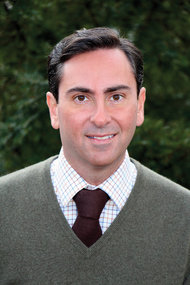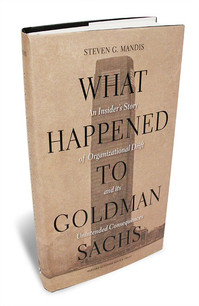Source of book image: http://s.wsj.net/public/resources/images/OB-ZF094_bkrvgo_GV_20131008133334.jpg
(p. B8) Steven G. Mandis, a Ph.D. candidate in sociology at Columbia University, takes a measured, academic approach to the question in a new book, “What Happened to Goldman Sachs,” an examination of the bank’s evolution from an elite private partnership to a vast public corporation — and the effects of that transformation on its culture.
. . .
Mr. Mandis said that the two popular explanations for what might have caused a shift in Goldman’s culture — its 1999 initial public offering and subsequent focus on proprietary trading — were only part of the explanation. Instead, Mr. Mandis deploys a sociological theory called “organizational drift” to explain the company’s evolution.
The essence of his argument is that Goldman came under a variety of pressures that resulted in slow, incremental changes to the firm’s culture and business practices, resulting in the place being much different from what it was in 1979, when the bank’s former co-head, John Whitehead, wrote its much-vaunted business principles.
These changes included the shift to a public company structure, a move that limited Goldman executives’ personal exposure to risk and shifted it to shareholders. The I.P.O. also put pressure on the bank to grow, causing trading to become a more dominant focus. And Goldman’s rapid growth led to more potential for conflicts of interest and not putting clients’ interests first, Mr. Mandis says.
For the full review, see:
PETER LATTMAN. “An Ex-Trader, Now a Sociologist, Looks at the Changes in Goldman.” The New York Times (Tues., October 1, 2013): B8.
(Note: ellipsis added.)
(Note: the online version of the review has the date SEPTEMBER 30, 2013.)
The book under review is:
Mandis, Steven G. What Happened to Goldman Sachs: An Insider’s Story of Organizational Drift and Its Unintended Consequences. Boston, MA: Harvard Business School Publishing, 2013.

“Steven G. Mandis is the author of “What Happened to Goldman Sachs.”” Source of caption and photo: online version of the NYT article quoted and cited above.

